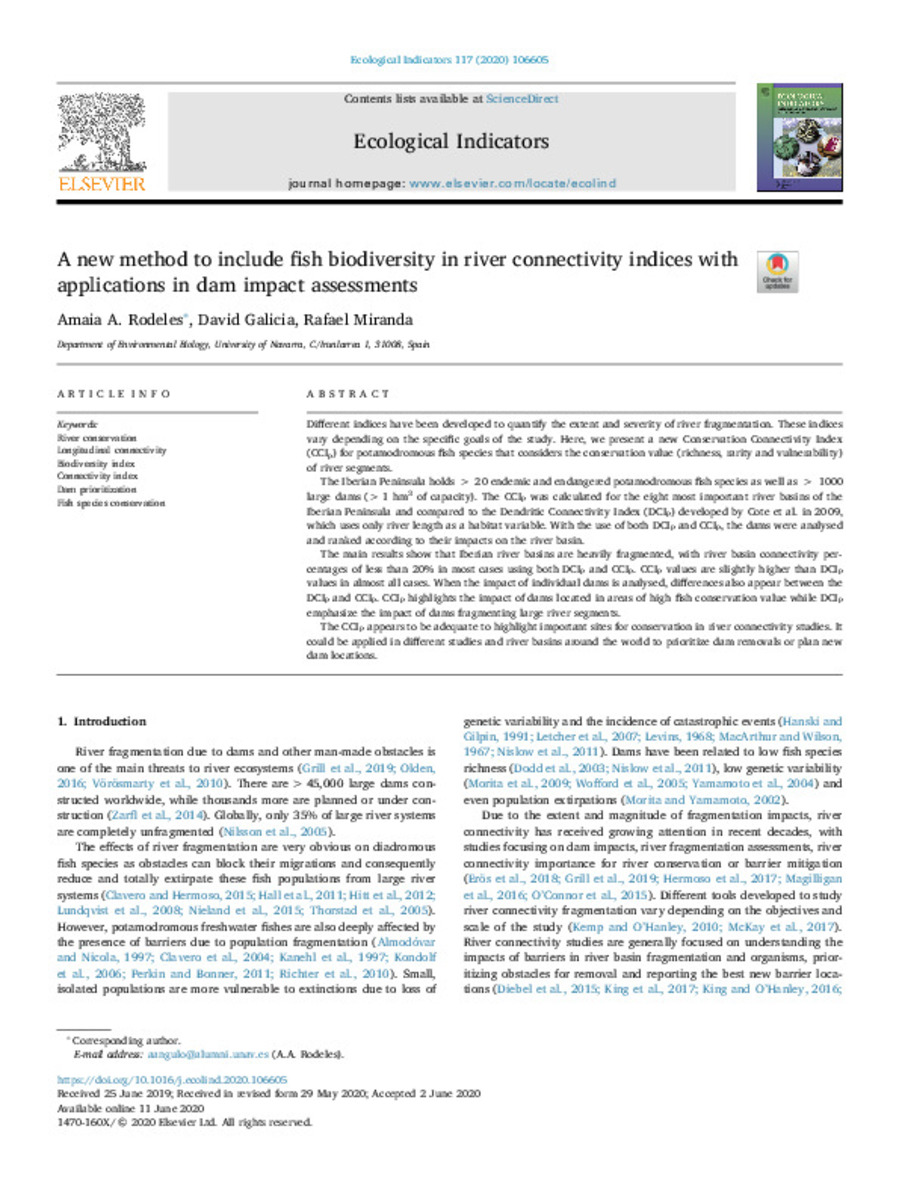Full metadata record
| DC Field | Value | Language |
|---|---|---|
| dc.creator | Rodeles, A.A. (Amaia A.) | - |
| dc.creator | Galicia-Paredes, D. (David) | - |
| dc.creator | Miranda-Ferreiro, R. (Rafael) | - |
| dc.date.accessioned | 2023-02-13T13:58:04Z | - |
| dc.date.available | 2023-02-13T13:58:04Z | - |
| dc.date.issued | 2020 | - |
| dc.identifier.citation | Rodeles, A.A. (Amaia A.); Galicia-Paredes, D. (David); Miranda-Ferreiro, R. (Rafael). "A new method to include fish biodiversity in river connectivity indices with applications in dam impact assessments". Ecological Indicators. 117, 2020, 106605 | es_ES |
| dc.identifier.issn | 1470-160X | - |
| dc.identifier.uri | https://hdl.handle.net/10171/65412 | - |
| dc.description.abstract | Different indices have been developed to quantify the extent and severity of river fragmentation. These indices vary depending on the specific goals of the study. Here, we present a new Conservation Connectivity Index (CCIP) for potamodromous fish species that considers the conservation value (richness, rarity and vulnerability) of river segments. The Iberian Peninsula holds > 20 endemic and endangered potamodromous fish species as well as > 1000 large dams (> 1 hm3 of capacity). The CCIP was calculated for the eight most important river basins of the Iberian Peninsula and compared to the Dendritic Connectivity Index (DCIP) developed by Cote et al. in 2009, which uses only river length as a habitat variable. With the use of both DCIP and CCIP, the dams were analysed and ranked according to their impacts on the river basin. The main results show that Iberian river basins are heavily fragmented, with river basin connectivity percentages of less than 20% in most cases using both DCIP and CCIP. CCIP values are slightly higher than DCIP values in almost all cases. When the impact of individual dams is analysed, differences also appear between the DCIP and CCIP. CCIP highlights the impact of dams located in areas of high fish conservation value while DCIP emphasize the impact of dams fragmenting large river segments. The CCIP appears to be adequate to highlight important sites for conservation in river connectivity studies. It could be applied in different studies and river basins around the world to prioritize dam removals or plan new dam locations. | es_ES |
| dc.description.sponsorship | Amaia A. Rodeles was supported by a Ph.D. grant awarded by the Government of Navarra. | es_ES |
| dc.language.iso | spa | es_ES |
| dc.publisher | Elsevier | es_ES |
| dc.rights | info:eu-repo/semantics/openAccess | es_ES |
| dc.subject | River conservation | es_ES |
| dc.subject | Longitudinal connectivity | es_ES |
| dc.subject | Biodiversity index | es_ES |
| dc.subject | Connectivity index | es_ES |
| dc.subject | Dam prioritization | es_ES |
| dc.subject | Fish species conservation | es_ES |
| dc.title | A new method to include fish biodiversity in river connectivity indices with applications in dam impact assessments | es_ES |
| dc.type | info:eu-repo/semantics/article | es_ES |
| dc.description.note | Ecological Indicators is a peer reviewed, open access journal. | es_ES |
| dc.identifier.doi | 10.1016/j.ecolind.2020.106605 | - |
| dadun.citation.publicationName | Ecological Indicators | es_ES |
| dadun.citation.startingPage | 106605 | es_ES |
| dadun.citation.volume | 117 | es_ES |
Files in This Item:
Statistics and impact
Items in Dadun are protected by copyright, with all rights reserved, unless otherwise indicated.






